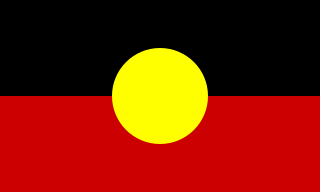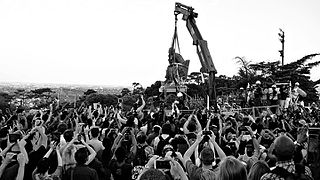
Indigenous Australian art includes art made by Aboriginal Australians and Torres Strait Islanders, including collaborations with others. It includes works in a wide range of media including painting on leaves, bark painting, wood carving, rock carving, watercolour painting, sculpting, ceremonial clothing and sandpainting; art by Indigenous Australians that pre-dates European colonisation by thousands of years, up to the present day.

The Gwion Gwion rock paintings, Gwion figures, Kiro Kiro or Kujon are one of the two major regional traditions of rock art found in the north-west Kimberley region of Western Australia. The identity of the artists and the age of the art are contended within archaeology and amongst Australian rock art researchers. A 2020 study estimates that most of the anthropomorphic figures were created 12,000 years ago, based on analysis of painted-over wasps' nests. These aspects have been debated since the works were seen, and recorded, in 1891 by pastoralist Joseph Bradshaw, after whom they were named until recent decades. As the Kimberley is home to many traditional owners, the rock art is referred to and known by many different names in the local languages, the most common of which are Gwion Gwion or Kiro Kiro/Giro Giro. The art consists primarily of human figures ornamented with accessories such as bags, tassels and headdresses.

In archaeology, rock art is human-made markings placed on natural surfaces, typically vertical stone surfaces. A high proportion of surviving historic and prehistoric rock art is found in caves or partly enclosed rock shelters; this type also may be called cave art or parietal art. A global phenomenon, rock art is found in many culturally diverse regions of the world. It has been produced in many contexts throughout human history. In terms of technique, the four main groups are:

Aboriginal Australians are the various indigenous peoples of the Australian mainland and many of its islands, but excluding the ethnically distinct people of the Torres Strait Islands. The term "Indigenous Australians" is applied to Aboriginal Australians and Torres Strait Islanders collectively.
Community archaeology is archaeology by the people for the people. The field is also known as public archaeology. There is debate about whether the terms are interchangeable; some believe that community archaeology is but one form of public archaeology, which can include many other modes of practice, in addition to what is described here. The design, goals, involved communities, and methods in community archaeology projects vary greatly, but there are two general aspects found in all community archaeology projects. First, community archaeology involves communities "in the planning and carrying out of research projects that are of direct interest to them". Second, community archaeologists generally believe they are making an altruistic difference. Many scholars on the subject have argued that community collaboration does not have a pre-set method to follow. Although not found in every project, there are a number of recurring purposes and goals in community archaeology. Similarities are also found in different countries and regions—due to commonalities in archaeological communities, laws, institutions, and types of communities. It has also been suggested that public archaeology can be defined in a broad sense as the production and consumption of archaeological "commodities".

Heather Burke is an Australian historical archaeologist and a Professor in the College of Humanities, Arts and Social Sciences at Flinders University.

Indigenous archaeology is a sub-discipline of Western archaeological theory that seeks to engage and empower indigenous people in the preservation of their heritage and to correct perceived inequalities in modern archaeology. It also attempts to incorporate non-material elements of cultures, like oral traditions, into the wider historical narrative. This methodology came out of the global anti-colonial movements of the 1970s and 1980s led by aboriginal and indigenous people in settler-colonial nations, like the United States, Canada, and Australia. Major issues the sub-discipline attempts to address include the repatriation of indigenous remains to their respective peoples, the perceived biases that western archaeology's imperialistic roots have imparted into its modern practices, and the stewardship and preservation of indigenous people's cultures and heritage sites. This has encouraged the development of more collaborative relationships between archaeologists and indigenous people and has increased the involvement of indigenous people in archaeology and its related policies.
The American-Australian Scientific Expedition to Arnhem Land remains one of the most significant, most ambitious and least understood expeditions. Commenced in February 1948, it was one of the largest scientific expeditions to have taken place in Australia and was conducted by a team of Australian and American researchers and support staff.

Robert H. Layton is a British anthropologist and Fellow of the British Academy. He is Emeritus Professor of Anthropology at Durham University. He has carried out fieldwork in rural France and in a number of Aboriginal communities in Australia, and recently on traditional craft in rural China. Robert Layton studied anthropology at University College London under the famous Australian anthropologist Phyllis Kaberry. He completed his DPhil under the supervision of F.G. Bailey at the University of Sussex. He is known for his eclectic approach to anthropology and diverse range of interests. He has written extensively about art, archaeology, the evolution of hunter-gatherer society and culture, the co-evolution of genes and culture, social change and anthropological theory. He was the recipient of the Royal Anthropological Institute's Rivers Memorial Medal for a substantive contribution to anthropology in 2003
Harry Lourandos is an Australian archaeologist, adjunct professor in the Department of Anthropology, Archaeology and Sociology, School of Arts and Social Sciences at James Cook University, Cairns. He is a leading proponent of the theory that a period of hunter-gatherer intensification occurred between 3000 and 1000 BCE.
Professor Michael John Morwood was a New Zealand archaeologist best known for discovering Homo floresiensis. In 2012, he received the Rhys Jones Medal by the Australian Archaeological Association.

Alice Gorman FSA is an Australian archaeologist, heritage consultant, and lecturer, who is best known for pioneering work in the field of space archaeology and her Space Age Archaeology blog. Based at Flinders University, she is an expert in Indigenous stone tool analysis, but better known for her research into the archaeology of orbital debris, terrestrial launch sites, and satellite tracking stations. Gorman teaches modern material culture studies, cultural heritage management, and Australian stone tools. Gorman is also a founding member of the Archaeology, Science and Heritage Council of For All Moonkind, Inc., a nonprofit organisation developing and seeking to implement an international convention to protect human cultural heritage in outer space.
Madjedbebe is a sandstone rock shelter in Arnhem Land, in the Northern Territory of Australia, possibly the oldest site of human habitation in Australia. It is located about 50 kilometres (31 mi) from the coast. It is part of the lands traditionally inhabited by the Mirarr, an Aboriginal Australian clan of the Gaagudju people, of the Gunwinyguan language group. Although it is surrounded by the World Heritage Listed Kakadu National Park, Madjedbebe itself is located within the Jabiluka Mineral Leasehold.
Laila Haglund is an archaeologist who played a key role in establishing consulting archaeology in Australia, and in drafting Queensland's first legislation to protect Aboriginal cultural heritage.
Dr Josephine McDonald is an Australian archaeologist and Director of the Centre for Rock Art Research + Management at the University of Western Australia. McDonald is primarily known for her influence in the field of rock art research and her collaborative research with Australian Aboriginal communities.
Sally Kate May, usually cited as Sally K. May, is an Australian archaeologist and anthropologist. She is an Associate Professor of Archaeology and Museum Studies at the University of Adelaide, Australia. She is a specialist in Indigenous Australian rock art and Australian ethnographic museum collections.

Paulette F. C. Steeves is the Canada Research Chair in Healing and Reconciliation at Algoma University.

Decolonization of knowledge is a concept advanced in decolonial scholarship that critiques the perceived hegemony of Western knowledge systems. It seeks to construct and legitimize other knowledge systems by exploring alternative epistemologies, ontologies and methodologies. It is also an intellectual project that aims to "disinfect" academic activities that are believed to have little connection with the objective pursuit of knowledge and truth. The presumption is that if curricula, theories, and knowledge are colonized, it means they have been partly influenced by political, economic, social and cultural considerations. The decolonial knowledge perspective covers a wide variety of subjects including philosophy, science, history of science, and other fundamental categories in social science.
Lynley A. Wallis is an Australian archaeologist and Associate Professor at Griffith University. She is a specialist in palaeoenvironmental reconstruction through the analysis of phytoliths.









